
Nearly 40 years ago, a small little software start-up in Silicon Valley named Pixar began experimenting with graphic design using computers to create three dimensional imagery. While they were not the first to use computers to create graphics, they were however the first to apply the technology to the art of animation. Moving beyond just simple shapes and patterns, Pixar began to design images that could move and even have personality. This was proven especially well in the 1986 short Luxo Jr., where they took a computer modeled digital puppet of a desk lamp (an ordinarily inanimate object) and made it not only come to life, but with personality as well. Luxo Jr., that simple test run of Pixar’s animation capabilities has gone on to become the mascot of one of the most revered and groundbreaking studios in animation ever since. With their award winning and acclaimed shorts gaining increasing attention in the field of animation, Pixar took on some high profile investors to help boost them even further, including big names like George Lucas and Steve Jobs. Eventually, their ambitions rose leading them to take on the biggest challenge yet; to create a feature length computer animated film. It’s not at all surprising that the ones who helped Pixar achieve that dream was Disney Animation. Disney themselves had undertaken the same risks that Pixar did in it’s early days, and given that Disney has long been a forward thinking studio when it comes to emerging technology, it was particularly wise of them to bring Pixar into the fold before they would grow into a competitor. While Disney has still maintained their own in house animation studio, they have still managed to let Pixar grow alongside it, seeing it become one of the most beloved brands in all of animation history. In 1995, the two studios launched the groundbreaking film Toy Story, changing the face of animation forever, and today, Pixar reaches a major milestone with their 25th feature film.
Turning Red makes it’s debut this week on Disney+, an unfortunately limited release affected by Disney’s post pandemic strategy of releases. It’s too bad that the occasion of Pixar’s 25th film is being platformed in a way that is not ideal for the best possible experience. This is also the third film in a row from Pixar to be debuting on streaming instead of in theaters, after Soul (2020) and Luca (2021), which leads many to wonder if Disney is intentionally mistreating their Pixar brand in favor of their own, as both Raya and the Last Dragon (2021) and Encanto (2021) did get theatrical releases. Some would argue that a streaming release is more beneficial in this day and age, but there’s still debate over that. Unfortunately, for many who prefer the theatrical experience, they are being robbed of a choice and it seems like Pixar is being singled out as the fall guy here for Disney’s internal corporate shuffling. But, enough of my soap box ranting. It is indeed a huge milestone to make for Pixar animation, and it’s worth looking back on all the things that has made Pixar the beloved studio that it is today. What really has defined Pixar the most over the years is their incredible mastery over story. Each Pixar to be sure is visually daring and groundbreaking, but it’s the emotional connection that they make with audiences that has endeared them to multiple generations. They have managed to make us laugh out load one minute and then be brought to tears in the next. It’s not surprising that so much effort is put into the story development first before each of their movies goes into animation, because they know that story is the heartbeat of their brand. And what they really excel at are creating what we know as a Pixar moment; one that tears at our hearts or warms it pure joy and sometimes awe. Below, I have selected what I think are the most iconic and memorable moments from the first 25 films in the Pixar canon. Only the main lineup of full length movies here, so no shorts or spin-offs. And these aren’t particularly all the saddest moments or the funniest, but moments that I think helped to define Pixar as the kings and queens of animation that they are today. So, without further ado, let’s look at the best moments from Pixar Animation…so far.
10.

THE DOOR VAULT from MONSTERS INC. (2001)
By the time that Monsters Inc. came around, Pixar had already established itself as a studio that excelled at world building. They showed us the lives of toys that come to life when the humans are not watching in Toy Story (1995) and Toy Story 2 (1999), and they also showed us the world from the perspective of the insect world with A Bug’s Life (1998). With Monsters Inc., they showed us an alternate world where monsters lived the same kind of lives as ordinary humans. Up until then, this kind of world building was really unique in animation, utilizing an almost unprecedented amount of detail in the backgrounds to subtly suggest how the world of the monsters is both familiar and alien at the same time. But, Pixar was not just satisfied in making their world of the monsters feel plausible and lived in. They wanted to really show what they were capable of with the advances they had made in their medium. One of the most interesting concepts they created in the film was the idea of trans-dimensional doors that allow the monsters to enter the world of humans. These doors simply are modular door frames that can be carried of once it’s usefulness is complete, which then raised the question for the filmmakers; where do those doors go. The answer was a cavernous vault with crisscrossing rails to transport the doors on an assembly line. It’s here that the filmmakers also wisely chose to set the climax of their story, giving the movie an extra bit of epic grandeur. As we see Mike and Sulley and lil’ Boo fly across this massive repository, it showed just how far Pixar had some in such a short time. Here they were able to blow us a way with creating an environment on a scale unseen before with literally thousands of moving parts all being showed at once. In addition, it also gives the climax of the movie a roller coaster style adrenaline rush as the characters fly from door to door, and even through the dimensions between. It’s a finale that set the bar high and really took Pixar to a whole different level.
9.
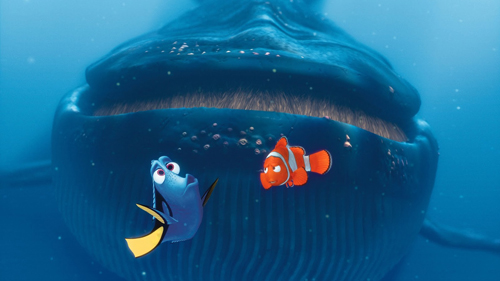
DORY SPEAKING WHALE from FINDING NEMO (2003)
We go from one of Pixar’s grandest moments to one of it’s sillier, but no less memorable, moments. Finding Nemo is a film built around a whirlwind of emotions, ranging from the tragic opening scene, to the harrowing escape from a swarm of jellyfish, to the hilarious attempts at escaping from a fish tank. But, where most of the love for this film comes from is the brilliant comedic chemistry of it’s two leads; the neurotic clownfish father Marlin (voiced by Albert Brooks) and the absent-minded but good natured Dory (voiced by Ellen Degeneres). Most of the film’s adventures are built around the situations that this unlikely pair finds themselves in, and the comedy is derived from their Abbott and Costello like banter. While there are many hilarious moments to speak of, the movie hits a high point with the hilarious moment that Dory tries to demonstrate her ability to speak whale, which she may or may not really have. While Ellen Degeneres’ vocal performance here is without a doubt hilarious, fearlessly diving into what whale speak might sound like with low pitch droning, it’s the fact that the movie gives the time to let this bit play out that makes it all the funnier. Most animated movies would hesitate devoting such a lengthy amount of their runtime to something like the vaudeville routine here between Dory and Marlin, but the film’s director, Andrew Stanton, wisely lets his two veteran comics deliver in that moment and plays the hilarity out to the fullest, allowing it to get funnier the longer it goes on. It also still fits as part of the progression of the story, because the scene also builds tension as a whale slowly approaches them from behind and ends up catching them in it’s expansive mouth; which we soon learn was to help them safely to their destination. It’s a scene that really demonstrates Pixar’s confidence in storytelling, and knowing exactly to let a good funny scene breath to full life.
8.
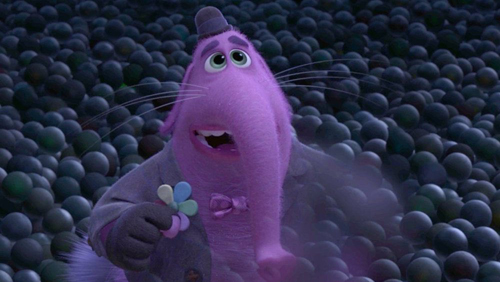
BING BONG’S SACRIFICE from INSIDE OUT (2015)
Now we go from one of Pixar’s funniest moments to one of it’s most heartbreaking. Seems fitting that a movie where the main characters are the embodiments of our inner emotions would also be an emotional roller coaster itself. Taking place mostly in the mind of a twelve year old girl named Riley, we follow her emotions as they take a journey through all of it’s inner workings in order to return to the central headquarters and set things back in motion after it’s all gone haywire. The emotions taking that journey in particular are Joy (voiced by Amy Poehler) and Sadness (Phyllis Smith); polar opposites to be sure. On their road, they run into Riley’s semi-forgotten imaginary friend named Bing Bong (voiced by Pixar regular and favorite Richard Kind). Now Bing Bong is certainly a character meant to give the movie another comical foil to bring laughter to the audience. What the movie manages to remarkably do is garner an emotional attachment to the character as well. This becomes especially clear at a point in the story where both he and Joy fall into a part of the Riley’s mind where memories go to be forgotten forever, with no chance of escape. Not only are they stuck there, but Bing Bong finds that he is slowly starting to fade being in that dark abyss as well. The duo do manage to find an escape aboard a rocket powered red wagon, but they can’t both make it out together. Seeing the stakes at play, Bing Bing bails out, allowing Joy to escape. Because of this, Bing Bong is doomed to be forgotten and he fades from existence before our eyes, but not before advising Joy to take Riley “to the moon” for him. In that moment right there, Pixar managed to do something that you’d never think possible; to shed a tear for a character named Bing Bong, an elephant trunked creature made of cotton candy that cries candy. But that just shows how good Pixar is at making us care about the stories they tell and the characters they bring to life, no matter how silly they are.
7.
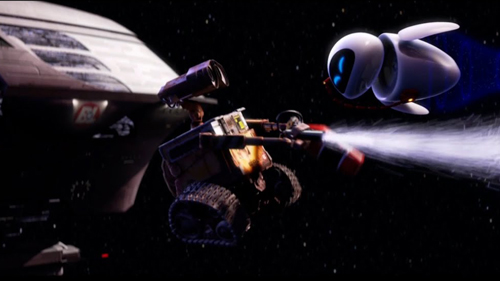
WALL-E AND EVE’S STARLIGHT DANCE from WALL-E (2008)
Wall-E may very well be the most ambitious movie in the Pixar canon, at least conceptually. Taking place in the far future where humanity has left the Earth behind as an unlivable trash heap, we are introduced to a lone trash collecting robot that has lived alone for centuries on the planet and over time has developed a personality of his own. Once he meets a probe robot named Eve who has ventured to Earth in search of sustainable plant life (a sign that Earth’s toxicity is waning and capable of supporting human activity again) Wall-E begins an adventure that leads him out into the cosmos. Along the way, he also develops a kinship with Eve, which blossoms into deep affection between the two. This highly unusual but nevertheless endearing love story hits a high point after Wall-E finds himself floating in space, propelled by a fire extinguisher. Eve, who is self-propelled, playfully follows beside him, and their gliding through space turns into an elegant dance around the massive spaceship. Made even more romantic by the Thomas Newman score, this is one of the most elegantly beautiful sequences ever put in any animated film, let alone Pixar. And it’s all the more remarkable because these are characters that are limited in expression and voice, and yet full of personality. There’s an especially hilarious and heartwarming moment when Eve and Wall-E touch each other’s heads and a little spark slashes; the robot equivalent of a kiss. Wall-E’s lucid reaction afterwards is especially endearing. Who knew that simple robots could create one of the most romantic couples in animation history? Couple this with outer worldly animation and you’ve got the makings of one of Pixar’s most elegantly sublime moments.
6.
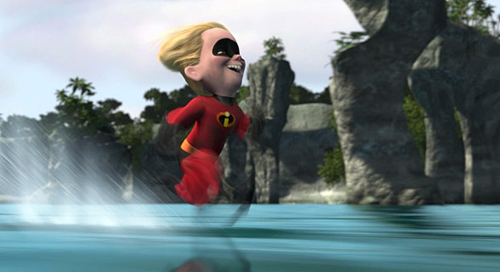
THE 100 MILE DASH from THE INCREDIBLES (2004)
When Pixar brought in legendary animation director Brad Bird into their stable, they knew he would bring something bold and cutting edge to their next project. The Iron Giant auteur took his long in development idea of a family of super heroes and crafted Pixar’s most groundbreaking film yet. You can tell that Pixar took a great leap forward in terms of staging with The Incredibles; with the scale of action going much further than we’ve seen before in animation. Bird stages his scenes like an action movie in the vein of a Mission: Impossible film (something that would also be in Brad Bird’s future), but with the boundless potential that computer animation can allow him. This is especially shown off to it’s extreme in the sequence involving the super speedster Dash and his harrowing escape from the villain’s henchmen. Dash, the 10 year old middle child of the super powered Parr family, has spent much of the film being held back by his concerned mother, who has kept him from running at his fullest speed in order to help conceal their identity. But, as the family attempts to infiltrate the villain’s lair in order to save the father, Mr. Incredible, the limits are gone, and we finally see just how fast Dash can run. The scene is an absolute tour de force of animation, with the medium reaching an epic scale unlike anything seen before. And what is especially great is how Brad Bird builds the momentum of the action in the scene, really amping up the excitement for the viewer. There’s also some great subtle character moments in there as well, like the look of joy on Dash’s face when he realizes he can run on water for the first time. This is an especially good scene to show off as a tech demo for computer animation, because of all the moving parts involved. And what is especially special about this scene was that it showed that computer animation could indeed be as dynamic as anything live action could make, and even more so. For a movie that already had plenty of great action set pieces, this is one that really raised the bar high for what animation could do, and it still is a thrilling ride all these years later.
5.
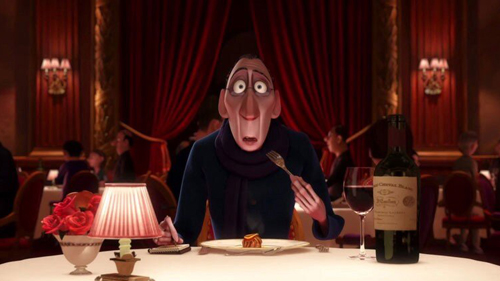
EGO’S EPIPHANY from RATATOUILLE (2007)
What other studio out there would dare to have the climax of their movie hinge on the preparation and eating of a meal in a fancy restaurant. Once again from the mind of Brad Bird, the story of a rat named Remy (voiced by Patton Oswalt) who wants to become a gourmet chef in Paris naturally would end on an unconventional note. But it’s a moment that so perfectly encapsulates the story that they want to tell. Ratatouille is a story about artistic pursuit, and not letting one’s background be an obstacle towards creating authentic moments of genius. For much of the movie, there has been this looming threat of a food critic named Anton Ego (voiced marvelously by the legendary Peter O’Toole), whose become this ruthless gatekeeper over the standard of quality dining in the city of Paris. Impressing him seems like an almost insurmountable challenge, and it’s made even more harrowing when the cook in question is a rat. But in a moment that is just pure brilliance, Remy the rat cooks up the titular dish, which his fellow cooks are uncertain about because Ratatouille is considered a peasant dish in French circles. But, with a confidence in his abilities, he send the dish to Ego’s table. Ego takes one bite and the movie suddenly flashes us back to Ego’s childhood, where we see his mother cheer him up by cooking the same meal. It then brings us right back to present day with Ego looking gobsmacked. It’s hilarious, but it also perfectly brings the movie full circle. The dour critic has his guard taken down because he finally found a meal that reminds him of why he loves food in the first place. It’s the way that Brad Bird reveals all this information in just a few quick seconds that makes this moment so resonant. We’ve all had that moment that touched our souls and made us fall in love with something, and it’s hilarious to see it so sharply realized in a quick cut-away gag. Only Pixar would end their movie on that kind of note, and it’s a testament to their capabilities as storytellers.
4.

JESSIE’S STORY from TOY STORY 2 (1999)
One of the other great talents of the story teams at Pixar is their ability to tell so much story within a brief amount of time, even in the span of one musical number. This was especially well demonstrated in their third film; the sequel to their first feature Toy Story. In Toy Story 2, the pull-sting cowboy doll Woody (voiced by Tom Hanks) meets for the first time other toys that were part of the same line of merchandise that he came from. One of them is a perky, yodeling cowgirl named Jessie (voiced with great zeal by Joan Cusack). While Jessie is full of life and spunk, we do see a lot of pain in her character as well, which we soon learn more about when she finally reveals to Woody where she came from. The movie shifts to a backstory told entirely through song (written by Randy Newman, and performed by Sarah McLaughlin) where we see the events of Jessie’s life played out in montage. We see her living a happy life as she’s played with by her owner; a little girl named Emily. Eventually Emily grows up, and forgets about Jessie, who spends years alone under the bed, un-played with. Then, when Emily is in adulthood she finds Jessie, and the little doll briefly finds happiness again, thinking that she’s been reunited with her beloved companion. But, to her great disappointment, she soon learns that she’s being dropped off to a second hand donation box, abandoned by the one she thought would love her forever. In one somber song sequence, Toy Story 2 gives us a harrowing tragic story that could’ve stood on it’s own. It works brilliantly as a moment in this film because it echoes the anxieties that Woody himself was having in that moment, worried that his owner Andy would soon leave him behind too. This moment is definitely a significant one in Pixar history because it’s arguably their first tear-jerking moment; something that they would go on to create many more of. Of course, Pixar wouldn’t have had the confidence to continue making these emotional, heart-string tugging moments in their films had this one not landed so well in the first place. Pixar certainly knows how to deliver a good cry in their movies, and it’s with Jessie’s emotional journey that we saw them earn that moment for the first time.
3.
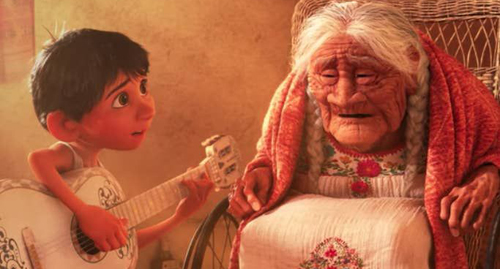
REMEMBER ME from COCO (2017)
Another moment that gave audiences a good cry in the theater, Pixar’s Coco hits it’s most emotional note at the climax of it’s story. For most of it’s run time, Coco had been an imaginative romp through a world reflective of the traditions of the holiday Dia de Los Muertos, celebrated throughout the nation of Mexico and many other Latin American countries. Through the brilliant imaginations of the artists at Pixar, we see the Land of the Dead as this vibrant society, where ancestral souls live on, embodied as colorful skeletal versions of their past selves. We follow along with a young boy named Miguel (voiced by newcomer Anthony Gonzalez), who must find his way back to the living after having a curse placed on him. Along the way, he meets a vagabond soul named Hector (voiced by Gael Garcia Bernal), and learns that if Hector doesn’t find a way to get his long lost daughter to remember him, he will fade from the land of the dead into oblivion, in what is called the Final Death. Through a variety of circumstances, Miguel soon learns that Hector’s daughter is actually his great grandma Coco, who’s in the final stages of dementia. Miguel, knowing full well how much it matters to make Coco remember, returns home with a renewed sense of setting things right in his family. Up until this point, Miguel was acting in his own self interest in pursuing his dream to become a famous musician. But in the film’s climax, he sings not for himself but for his Mama Coco, to bring her back from the abyss and in turn help keep his ancestor Hector from fading away completely. It’s an emotional gut punch, especially for those with loved ones who have been lost to Alzheimer’s and dementia. Seeing the life come back into Coco’s eyes when Miguel sings to her is such a powerful moment, with a song that is perfectly titled “Remember Me.” Who knew a song sung between an old lady and a young boy would hit such an emotional wallop, but that’s what makes this one in Coco such great scene and one of the absolute high points of Pixar’s film legacy.
2.

THE TOYS ARE ALIVE from TOY STORY (1995)
It wouldn’t be right to make a list of the greatest Pixar moments and not mention the movie that started it all. When Toy Story first came out in theaters, there was little certainty that it could actually work. At that time, hand drawn animation from the likes of Disney was dominating the marketplace, especially after the success of The Lion King (1994) just the year before. Computer animation was still a novelty, and also pretty primitive. Sure, Jurassic Park (1993) proved that you could make computer animation appear life-like, but an entirely animated world was something altogether unproven. But like Walt Disney had done with Snow White and the Seven Dwarves (1937) all those years ago, the artists at Pixar set out to prove the naysayers wrong and to do so, they put all their focus on getting the story right first and foremost. When you look back on Toy Story today, there are certainly things about it that really don’t date well, like the environmental textures and primitive human models that look very Barbie doll-like compared to what we have now. But, what does still work very well is the amount of personality that was put into the animation of the main toy characters. Woody and Buzz Lightyear still feel like fully fleshed out characters even by today’s standards, and while later Toy Story movies have refined the character models with better detail over the years, they still reflect the rock solid blueprint set by the original film. If there really was anything that made Pixar the powerhouse that they are today, it’s that first glorious moment when we see the toys come to life for the first time. It’s in that moment that Pixar announced itself to the world and showed that they could indeed make the impossible possible at their studio. That’s something that has carried them along with each subsequent film thereafter; the belief that they can breath life into these pixels on a computer screen and make us care for them. Like Disney before them, Pixar showed that their medium was just as cinematically relevant as any other, and it all it started with is making us believe that toys can come to life and that their stories could make us laugh and cry too.
1.
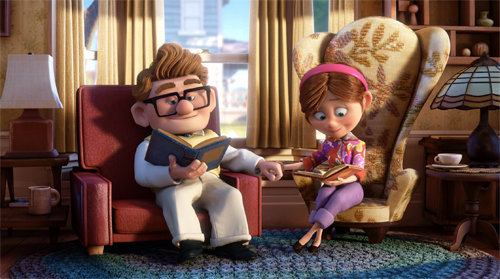
MARRIED LIFE from UP (2009)
While Toy Story broke new ground and movies like Coco, Inside Out, and Toy Story 2 could bring us to tears, the most perfect display of everything that Pixar excels at encapsulated in one sequence is found in the movie Up; a simple story about an old man and his journey aboard a balloon suspended house. The story of Carl Fredrickson (voiced by the late great Ed Asner) is an imaginative romp taking us to the skies and into the otherworldly wilds of the South American tepui mountaintops. But, what most people remember the most about Up is not the adventure itself, but the story that leads up to the main events. In the movie’s prologue, we see young Carl meet a spunky little girl named Ellie. The two make a quick bond, and then the movie cuts ahead to their wedding day. From there, Carl and Ellie’s adult lives are played out in a montage, set to the incredible Oscar-winning score of Michael Giacchino. We are shown the married life of these two soulmates in a scant six minutes, and yet their story is in itself a full three act narrative with the same highs and lows of a full length feature. We see the joy of starting a life together, the lows of learning of their infertility, the dreams of their hope to one day going on an adventure of a lifetime as well as the many speedbumps that prolong that dream. It’s all perfectly displayed with not a single spoken word. Director Pete Doctor includes some brilliant touches to help show the passage of time, like the many different times that Ellie adjusts Carl’s tie, that helps to make the montage flow gracefully along. And then of course comes the gut punch when time catches up to the couple and Ellie’s life passes at the close of the montage. In a brilliantly staged sequence like this, we see everything Pixar has perfected as cinematic storytellers, and remarkably this is how they chose to start the movie. Thankfully the rest of the film doesn’t waste let down the high bar set by this emotional opening. When you can tell a whole life’s story in a short little montage, and have the audience still feel invested and emotionally wrecked by the end, you know you’ve hit a very high standard as storytellers. This scene alone is already studied in film schools as a demonstration of perfect brevity in storytelling and montage filmmaking. And from the moment it first premiered, this became the high water mark that every emotionally resonant moment to come from Pixar has been judged against; some meet the challenge (Coco) others fall way short (Brave). There’s no doubt that when Pixar can break your heart with a short story about a happy marriage from beginning to end in a montage shorter than the end credits, it’s a sign of them coming to the full peak of their cinematic possibilities.
So, there you have my choices for the greatest moments in Pixar’s first 25 feature films. You’ll notice that the pattern of the list highlights Pixar’s uncanny ability to bring their audience to tears. I don’t think that their plan is to upset their audiences. The fact that most of us end up crying at their movies is because they are just so good at making us care about their characters and their stories; and some of the best stories out there often involve a little bit of heartbreak. That’s definitely true of the moments from Up, Inside Out, Toy Story 2 and a few more that I didn’t include on this list. But there’s also the triumphant moments that hit us very hard as well. Ratatouille’s triumphant breaking down of Ego’s cynical shell for example, or Woody and Buzz falling from the sky with “style,” in Toy Story, or even just a sweet little button to end the movie on like Sully reuniting with Boo at the end of Monsters Inc. What I especially like about Pixar is that they don’t pander to their audience; and when they do, it’s often from their worst films (the Cars franchise). I like how their stories are always challenging their audience to think, and they often leave us guessing how things will turn up in the end. That’s why so few of their films are binary, good vs. evil narratives. Somethings the obstacle that stands in the characters way are their own flaws, which they overcome through their journey. Marlin learns to not be so over-protective in Finding Nemo; Lightning McQueen learns that you can be the better man by not winning the race in Cars (2006); Joy learns that sometimes you need a good cry in order to feel happy again in Inside Out. Pixar has mastered the ability to tell complex stories in a way that doesn’t talk down to it’s audience, no matter what age they are. That’s why they have become the vanguard of animation over the last four decades, and will likely continue to be in the years ahead. My hope is that their parent company Disney learns that these movies should be shared on the big screen alongside their presence on streaming. These are films that become even more magical when experienced with a whole audience of people. As shown here, they are some of the greatest storytellers in cinema today, and here’s hoping the next 25 movies stand just as strong as the first.